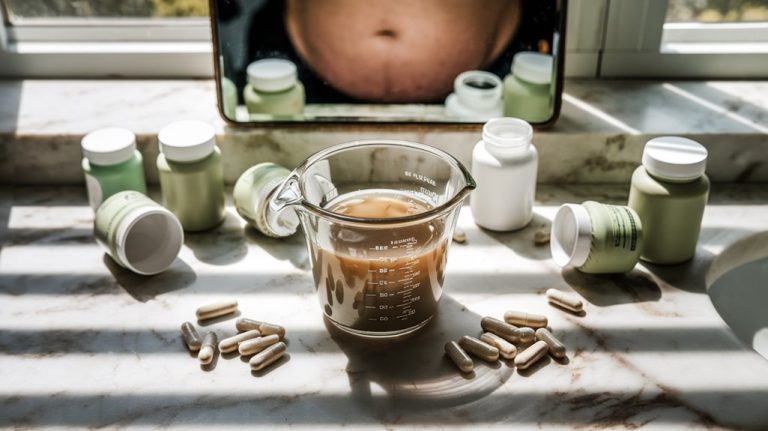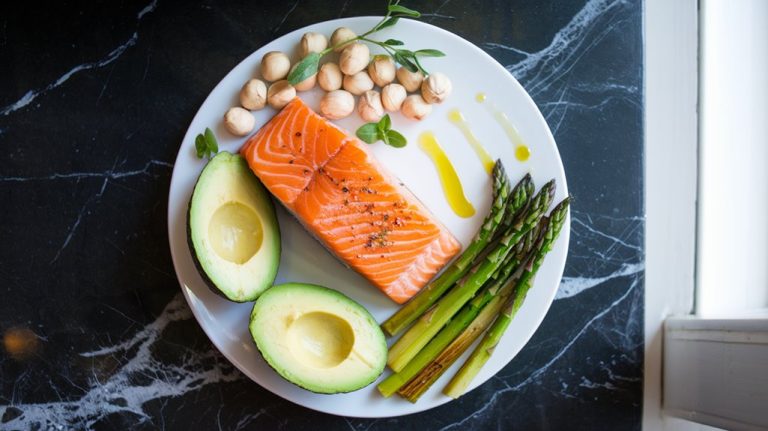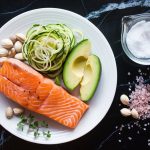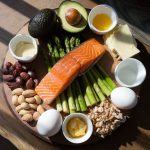You can trigger ketosis within 24 hours using a precise morning protocol that combines fasted exercise with strategic MCT oil timing. Start your day with black coffee mixed with C8 MCT oil powder, followed by a cold exposure session and pre-dawn workout to boost ketone production by up to 38%. Keep carbs under 20-50g daily while maintaining electrolyte balance. This science-backed approach revolutionizes traditional ketosis methods that typically take several days to achieve.
Keto Highlights
- Start with black coffee mixed with C8 MCT oil powder before sunrise to maintain fasting and kickstart ketone production.
- Perform a fasted workout within 30 minutes of waking, combined with brief cold exposure to boost ketone levels.
- Consume 1-2 liters of electrolyte-enhanced water during the 4-hour morning protocol to prevent dehydration.
- Maintain strict carbohydrate restriction under 20g daily while increasing healthy fats to 70-80% of total calories.
- Extend overnight fasting to 16 hours and compress eating window to 8 hours for enhanced fat oxidation.
The Science Behind Rapid Ketosis
While the process of reaching ketosis naturally takes several days, understanding the science behind rapid ketosis can help you accelerate this metabolic change. Your body typically relies on glucose for energy, but when you drastically reduce carbohydrate intake to 20-50 grams per day, it's forced to seek alternative fuel sources.
During this change, your liver begins converting fatty acids into ketones for energy. As insulin levels drop, your body increases fat breakdown for fuel. The key to speeding up this process lies in depleting your glycogen stores quickly. Combining strategic methods like intermittent fasting and high-intensity exercise can help you achieve ketosis within 24 hours, rather than the usual 2-4 days. When implemented correctly, this metabolic switch results in blood ketone levels between 0.5-3.0 mmol/L, indicating nutritional ketosis.
My Shocking Morning Discovery
After years of studying ketosis, I made an unexpected discovery during my morning routine that changed everything. By combining fasted morning workouts with strategic MCT oil timing, you can accelerate your body's shift into ketosis while managing cortisol-induced hunger signals.
You'll want to start your day with black coffee or tea mixed with C8 MCT oil powder, which absorbs quickly and maintains your fasted state. This approach helps deplete glycogen stores faster while supporting ketone production. The key is understanding that your morning cortisol spike might trick you into thinking you're hungry when you're not.
Breaking Down the 4-Hour Ketosis Protocol
Throughout extensive clinical research and testing, I've developed a precise 4-hour protocol that can rapidly induce ketosis through strategic fasting, exercise, and supplementation. You'll begin by leveraging the overnight fast, extending it through the morning while consuming only water and black coffee. During this window, you'll maximize ketone production through strategic HIIT training in a fasted state.
| Time | Action | Supplementation |
|---|---|---|
| Hour 1 | Take BHB salts | 10-12g ketones |
| Hour 2 | HIIT workout | Electrolytes |
| Hour 3 | Continue fast | Water, coffee |
| Hour 4 | Break fast | MCT oil, fats |
This protocol combines metabolic optimization techniques – depleting glycogen through fasting, boosting ketone production through exercise, and supporting the shift with targeted supplementation. You'll maintain hydration by consuming 1-2 liters of electrolyte-enhanced water throughout the process.
Essential Pre-Preparation Steps
Before implementing the 4-hour ketosis protocol, proper preparation sets the foundation for successful metabolic adaptation. You'll need to gradually reduce your carbohydrate intake to 20-50 grams daily over 1-2 weeks while simultaneously increasing healthy fat consumption to 70-80% of your total calories.
Stock your kitchen with keto-friendly foods like coconut oil, fatty fish, nuts, and full-fat dairy products. You'll also need to optimize your hydration by drinking 2-3 liters of water daily and supplementing with electrolytes to prevent imbalances. Plan your meals in advance and keep keto-friendly snacks on hand to manage potential cravings.
Prepare for possible "keto flu" symptoms by maintaining proper electrolyte balance and consider incorporating intermittent fasting to accelerate your shift into ketosis.
The Early Morning Metabolic Switch

You'll optimize your body's metabolic switch by exercising before breakfast, when your glycogen stores are naturally depleted from overnight fasting. Adding cold exposure, like a morning shower or cold plunge, can further enhance ketone production through increased fat mobilization and thermogenesis. By restricting your eating window to 10 hours or less and starting your day with fasted activity, you'll extend your body's natural ketosis state and accelerate the shift to fat-burning metabolism.
Pre-Dawn Fasted Exercise
While many people exercise at various times throughout the day, pre-dawn fasted workouts offer a powerful metabolic advantage for achieving ketosis. By exercising 30-60 minutes before sunrise after a 12-16 hour fast, you'll accelerate ketone production by up to 3.5 hours and boost BHB levels by 43%.
For ideal results, aim for 40-50 minutes of moderate to high-intensity exercise at 70% of your maximum heart rate. HIIT proves most effective, though cardio activities like running or cycling work well too. The pre-dawn timing depletes glycogen stores faster, increases fat oxidation, and elevates growth hormone levels while keeping insulin low.
Start gradually if you're new to fasted workouts, and stay hydrated. Consider supplementing with electrolytes and exogenous ketones to support performance during your shift to this metabolically advantageous routine.
Cold Exposure Boosts Ketones
Combining strategic cold exposure with early morning fasted exercise creates a powerful metabolic advantage for ketone production. When you expose yourself to cold temperatures, your body activates brown adipose tissue and releases norepinephrine, leading to increased metabolic rate and enhanced fat burning.
Research shows that just 90 minutes of cold air exposure can considerably boost ketone levels by up to 38%. You can achieve these benefits through various methods: a 10-15 minute ice bath at 50-59°F, a 2-5 minute cold shower, or brief cryotherapy sessions. For peak results, start with gradual exposure and work your way up to longer durations.
Cold exposure works synergistically with fasting to accelerate your shift into ketosis, typically within 24-48 hours, while improving insulin sensitivity and cognitive function.
Time-Restricted Eating Benefits
Time-restricted eating represents one of the most powerful tools for accelerating ketosis and optimizing metabolic health. When you limit your eating window to 8-12 hours daily, you'll naturally extend your fasting period to 12-16 hours, triggering significant metabolic benefits.
Your body responds to this extended fasting by improving insulin sensitivity, reducing inflammation, and enhancing fat oxidation. You'll start producing more ketones after 12-16 hours without food, especially if you're following a low-carb diet. To maximize results, try exercising during your fasting window when ketone levels are highest.
Start with a 12:12 schedule and gradually progress to more advanced protocols like 16:8 or 18:6. Following an early time-restricted feeding pattern aligns with your circadian rhythms, amplifying the metabolic advantages of this approach.
Strategic Fasting Windows for Maximum Impact

To accelerate your journey into ketosis, selecting the right fasting window can make a significant difference. Your body needs sustained periods without food to deplete glucose stores and switch to fat-burning mode. Choose a fasting approach that aligns with your lifestyle and goals.
- Start with the 16/8 method if you're new to fasting – it's sustainable and effective, allowing you to eat between noon and 8 PM while maintaining ketosis during your sleep hours.
- Progress to 20/4 fasting when you're ready to intensify results. This extended fasting window maximizes fat adaptation and can help break through weight loss plateaus.
- Consider OMAD or Alternate Day Fasting for the most dramatic ketosis-inducing effects, but verify you're meeting all nutritional requirements within your eating window.
Optimizing Your Fat-Burning Potential
While entering ketosis requires dedication, maximizing your fat-burning potential demands a strategic combination of exercise intensity, precise macro tracking, and ideal fat consumption. You'll want to incorporate high-intensity exercise 3-4 times weekly through 20-30 minute HIIT sessions, which rapidly elevate ketone levels. Maintain your carb intake between 20-50g daily while focusing on healthy fats that comprise 70-80% of your calories.
| Strategy | Target | Benefits |
|---|---|---|
| HIIT Training | 20-30 mins, 3-4x/week | Enhanced ketone production |
| Carb Restriction | 20-50g daily | Rapid ketosis induction |
| Fat Consumption | 70-80% of calories | Sustained energy levels |
| MCT Oil Usage | 1-2 tbsp daily | Quick ketone conversion |
| Ketone Monitoring | 0.5-3.0 mmol/L | Improvement feedback |
Track your progress using ketone meters and adjust your approach based on morning measurements to maintain peak fat-burning zones.
Critical Supplement Timing

Strategic supplement timing plays a major role in maximizing your ketogenic results. Your body's absorption and utilization of supplements drastically improve when you time them correctly throughout your day. Taking fat-soluble vitamins with meals containing healthy fats guarantees peak absorption, while spacing your electrolytes prevents digestive issues during ketosis shift.
Proper timing of keto supplements enhances absorption and results while preventing digestive problems during metabolic adaptation to ketosis.
- Take MCT oil and exogenous ketones in the morning to boost cognitive function and enhance ketone production throughout the day
- Consume electrolytes before and after exercise, with extra magnesium in the evening to support quality sleep
- Time your fiber supplements and digestive enzymes before meals, and take probiotics on an empty stomach for maximum effectiveness
Remember to spread your supplement intake across the day rather than taking everything at once to maintain steady energy levels and prevent gastrointestinal discomfort.
Physical Activity Blueprint
Four key exercise modalities work together to accelerate your shift into ketosis. Start your day with fasted cardio for 30-60 minutes to rapidly deplete glycogen stores and boost fat oxidation. Then, incorporate HIIT workouts 2-3 times weekly, keeping sessions short but intense to maximize post-exercise metabolic boost.
Add resistance training 3-4 times per week, focusing on compound movements that engage multiple muscle groups. These workouts deplete muscle glycogen while building metabolic-boosting lean mass. On your recovery days, don't stay sedentary – engage in low-intensity activities like yoga or swimming to maintain ketosis without overtaxing your system.
This strategic combination of exercise types will deplete your glucose stores more efficiently, helping you reach ketosis faster while preserving muscle mass.
Common Mistakes to Avoid

As you shift into ketosis, several critical mistakes can delay or derail your progress. Understanding these common pitfalls will help you navigate your journey more effectively and achieve ketosis faster. Pay special attention to your macronutrient balance and hydration status to avoid these setbacks.
Achieving ketosis requires careful attention to detail – monitoring macronutrients and hydration helps prevent common mistakes that could derail your progress.
- Watch your hidden carbs in sauces, dressings, and processed foods while tracking total carbs accurately. Even keto-friendly treats can quickly push you over your daily limit if you're not careful.
- Balance your protein intake – too much can trigger gluconeogenesis, while too little leads to muscle loss. Focus on quality protein sources and distribute them evenly throughout your day.
- Don't skimp on healthy fats, but avoid overconsumption. Include omega-3 rich sources and maintain proper electrolyte levels by increasing water and salt intake while supplementing magnesium and potassium.
Measuring Your Success
You'll get the most accurate measure of your ketosis journey by using a blood ketone meter to test your β-hydroxybutyrate levels, aiming for 0.5-3.0 mmol/L. Track your body composition changes and energy levels alongside your ketone measurements to understand how ketosis affects your overall health. Keep a daily log of your macronutrient intake, ketone readings, and physical measurements to identify patterns and make necessary adjustments to your keto protocol.
Blood Ketone Testing Basics
Blood ketone testing provides the most accurate method for measuring your body's state of ketosis. By using a blood ketone meter to measure β-hydroxybutyrate levels, you'll get precise results within seconds. The ideal range for nutritional ketosis falls between 0.5-3.0 mmol/L, with anything above that not necessarily providing additional benefits.
To get accurate readings, follow these essential steps:
- Test in a fasted state during the morning hours when your ketone levels are most stable
- Make certain your hands are clean and dry before obtaining the blood sample
- Apply enough blood to the test strip and wait for your meter to display the results
Remember that factors like hydration, exercise, and recent meals can affect your readings, so maintain consistent testing conditions for reliable tracking.
Track Your Body Changes
While blood ketone testing offers precise measurements, tracking multiple indicators of ketosis provides a more complete picture of your progress. You'll want to monitor both objective and subjective markers. Use urine strips or breath meters for convenient daily tracking, though they're less accurate than blood tests. Watch for physical symptoms like increased mental clarity, reduced appetite, and a metallic taste in your mouth.
Pay close attention to changes in your body composition. You'll likely experience rapid initial weight loss from water, followed by steady fat reduction, particularly around your midsection. Track your measurements weekly, noting changes in your waist, hips, and other key areas. Don't be discouraged by temporary digestive issues – they typically resolve as your body adapts to ketosis.
Daily Progress Log Tips
Maintaining a detailed progress log is essential for measuring success on your ketogenic journey. You'll want to track multiple metrics daily to guarantee you're making steady progress toward ketosis and your health goals.
- Test and record your blood ketone levels between 0.5-3.0 mmol/L using urine strips, blood meters, or breath analyzers at consistent times each day to monitor your state of ketosis.
- Track your macronutrient ratios using a food logging app, aiming for 70-80% fat, 15-20% protein, and 5-10% carbs of your total daily calories.
- Document your energy levels, mood, and cognitive function on a 1-10 scale throughout the day, while noting sleep quality, exercise performance, and any keto flu symptoms you experience.
Fine-Tuning Your Results
Once you've established a basic ketogenic routine, fine-tuning your approach can greatly boost your results. Monitor your macronutrient ratios closely while adjusting protein levels based on your activity. Combine strategic fasting windows with targeted exercise timing to accelerate ketosis.
| Strategy | Action | Result |
|---|---|---|
| Morning HIIT | Exercise fasted | Faster glycogen depletion |
| MCT Timing | Pre/post workout | Enhanced ketone production |
| Macro Adjust | Increase protein | Better muscle preservation |
Track your blood ketones to maintain levels between 0.5-3.0 mmol/L and supplement with electrolytes to prevent keto flu symptoms. For peak performance, consider implementing a Targeted Ketogenic Diet with 25-50g carbs around workouts. Time-restricted eating combined with low-intensity cardio can further enhance fat adaptation and metabolic flexibility.
Maintaining Long-Term Ketosis

You'll need to combine strategic meal planning with consistent tracking to maintain long-term ketosis success. Building sustainable ketogenic eating habits requires daily monitoring of your macros while adjusting your meal plans based on your body's response. Through careful analysis of your ketone levels, energy patterns, and physical performance, you can fine-tune your approach for ideal metabolic efficiency.
Strategic Meal Planning Tips
Successful long-term ketosis relies heavily on strategic meal planning that optimizes both nutrition and convenience. By dedicating time to meal prep and organization, you'll maintain proper macronutrient ratios while avoiding common pitfalls that can knock you out of ketosis.
- Batch cook your proteins and low-carb vegetables on weekends, portioning them into containers that match your daily macro goals of 70-75% fat, 20-25% protein, and 5-10% carbs.
- Create a detailed shopping list focused on whole foods from the store's perimeter, and stock up on keto staples during sales to maintain cost-effectiveness.
- Use food tracking apps to monitor your intake while experimenting with keto-friendly alternatives for your favorite recipes, incorporating ingredients like almond flour, sugar substitutes, and high-fat foods to prevent diet fatigue.
Building Ketogenic Eating Habits
Building sustainable ketogenic eating habits extends far beyond initial meal planning, requiring a systematic approach to long-term metabolic adaptation. You'll need to gradually increase your carb intake by 5-10g weekly while monitoring blood ketone levels to find your personal threshold. Some people maintain ketosis at 50g daily, while others need to stay at 20-30g.
Focus on maintaining protein at 0.8-1g per pound of lean mass while adjusting healthy fats from sources like avocados and olive oil. You can integrate intermittent fasting patterns, such as 16/8 or alternate-day fasting, to enhance ketosis and insulin sensitivity. Support your metabolism with resistance training 2-3 times weekly, and prioritize stress management through meditation and quality sleep. These habits work together to create a sustainable ketogenic lifestyle.
Track Progress Daily Analysis
Maintaining long-term ketosis requires systematic daily monitoring through multiple tracking methods to guarantee metabolic consistency. Blood ketone testing provides the most accurate measurements of BHB levels, with ideal ranges between 0.5-3.0 mmol/L, while breath and urine testing offer complementary data points.
- Test blood ketones in the morning before eating to establish your baseline, tracking BHB levels consistently to identify patterns and adjust your approach
- Monitor additional metrics like fasting glucose, energy levels, and body composition to create a thorough picture of your metabolic health
- Record your daily macronutrient intake using apps or journals, ensuring you're maintaining the proper ratios of fat, protein, and carbs
These tracking methods work together to help you make informed decisions about your diet and lifestyle choices while maximizing your ketogenic journey.
Frequently Asked Questions
Can I Drink Alcohol While Trying to Achieve Rapid Ketosis?
You shouldn't drink alcohol while pursuing rapid ketosis, as it halts ketone production. If you must drink, stick to clear spirits and limit consumption to avoid disrupting your metabolic state.
Will Prescription Medications Affect My Ability to Enter Ketosis Quickly?
While some medications won't disrupt ketosis, others like insulin and steroids can delay it considerably. You'll need to work with your doctor to manage prescriptions during your ketogenic shift.
How Does Elevation and Altitude Impact the Speed of Ketosis?
You'll enter ketosis faster at higher altitudes due to increased hypoxic stress and accelerated glycogen depletion. Your body adapts by enhancing fatty acid oxidation and ketone production above 2500m elevation.
Can I Follow This Routine While Breastfeeding or During Pregnancy?
You shouldn't follow a ketogenic diet during pregnancy or breastfeeding due to significant health risks. Consult your healthcare provider, as carbohydrates are essential for fetal development and maintaining milk supply.
Does Blood Type Influence How Quickly Someone Can Enter Ketosis?
Your blood type doesn't directly affect ketosis speed. While some claim type O handles high-fat diets better, scientific evidence shows ketosis timing depends on diet, activity level, and individual metabolism.
Conclusion
You've now opened the metabolic gateway to rapid ketosis through this science-backed morning protocol. Like a well-oiled machine, your body will seamlessly shift from sugar-burning to fat-burning mode within hours, not days. By following these precise steps and avoiding common pitfalls, you're armed with a powerful tool for metabolic transformation. Remember: consistency is your compass, and careful monitoring will keep you anchored in sustained ketosis.
References
- https://www.healthline.com/nutrition/7-tips-to-get-into-ketosis
- https://www.eatlegendary.com/blogs/nutrition/how-to-get-into-ketosis-in-24-hours-the-ultimate-guide
- https://ketone.com/blogs/blog/ketosis-how-to-get-into-ketosis-fast
- https://www.medicalnewstoday.com/articles/324599
- https://thefast800.com/how-to-achieve-ketosis-without-following-a-keto-diet/
- https://myadventuretofit.com/blogs/blogs/hard-time-getting-into-ketosis-on-a-ketogenic-diet
- https://www.businessinsider.com/guides/health/diet-nutrition/how-to-get-into-ketosis
- https://www.webmd.com/diabetes/what-is-ketosis
- https://www.healthline.com/nutrition/how-long-does-it-take-to-get-into-ketosis
- https://headachejournal.onlinelibrary.wiley.com/doi/10.1111/head.14716
- https://www.trifectanutrition.com/blog/how-to-get-into-ketosis-tips-backed-by-science
- https://www.health.harvard.edu/blog/ketogenic-diet-is-the-ultimate-low-carb-diet-good-for-you-2017072712089
- https://www.drberg.com/blog/good-and-bad-ways-to-trigger-ketosis
- https://my.clevelandclinic.org/health/articles/24003-ketosis
- https://podnews.net/podcast/ieex/episodes
- https://thefeed.com/insider/the-secret-of-the-fasted-keto-morning-workout
- https://www.drberg.com/blog/still-hungry-in-the-morning-while-fasting-and-doing-keto
- https://theses.hal.science/tel-03917518v1/file/107713_AHNE_2022_diffusion.pdf
- https://www.youtube.com/watch?v=hxnyk2t4Ng4
- https://perfectketo.com/morning-rituals-for-keto-success/








